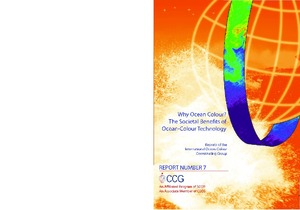| dc.coverage.spatial | Global | en_US |
| dc.date.accessioned | 2018-09-25T10:28:28Z | |
| dc.date.available | 2018-09-25T10:28:28Z | |
| dc.date.issued | 2008 | |
| dc.identifier.citation | IOCCG (2008) Why Ocean Colour? The Societal Benefits of Ocean-Colour Technology. (eds. Platt, T., Hoepffner, N., Stuart, V. and Brown, C.), Dartmouth, NS, Canada, International Ocean-Colour Coordinating Group (IOCCG), 141pp. (Reports of the International Ocean-Colour Coordinating Group, No. 7). DOI: http://dx.doi.org/10.25607/OBP-97 | en_US |
| dc.identifier.isbn | 978-1-896246-56-7 | |
| dc.identifier.uri | http://hdl.handle.net/11329/517 | |
| dc.identifier.uri | http://dx.doi.org/10.25607/OBP-97 | |
| dc.description.abstract | The concentration of chlorophyll in the ocean (or in fresh water) is an index of phytoplankton biomass, and is an important property that can be monitored through ocean colour radiometry (OCR) by Earth-orbiting spacecraft. OCR has revolutionised the field of biological oceanography, and made important contributions to biogeochemistry, physical oceanography, ocean-system modelling, fisheries oceanography and coastal management. This report illustrates the many applications of data acquired by remote sensing of ocean colour, in both the research and operational arena, demonstrating the benefits to society of investment in ocean-colour technology. Ocean colour is a key requirement in Earth observation. | en_US |
| dc.description.sponsorship | IOCCG sponsoring space agencies | en_US |
| dc.language.iso | en | en_US |
| dc.publisher | International Ocean Colour Coordinating Group (IOCCG) | en_US |
| dc.relation.ispartofseries | Reports of the International Ocean Colour Coordinating Group (IOCCG);7 | |
| dc.rights | Attribution-NonCommercial-NoDerivs 4.0 | * |
| dc.rights.uri | http://creativecommons.org/licenses/by-nc-nd/4.0/ | * |
| dc.title | Why Ocean Colour? The Societal Benefits of Ocean-Colour Technology. | en_US |
| dc.type | Report | en_US |
| dc.description.status | Published | en_US |
| dc.format.pages | 141pp. | en_US |
| dc.contributor.corpauthor | IOCCG | en_US |
| dc.description.notes | Contributing authors: James Acker, Ichio Asanuma, Stewart Bernard, Paula Bontempi, Christopher Brown,
Gordon Campbell, Heidi Dierssen, Paul DiGiacomo, Roland Doerffer, Mark Dowell,
Stephanie Dutkiewicz, Gene Feldman, Robert Frouin, Jim Gower, Nicolas Hoepffner,
Joji Ishizaka, Samantha Lavender, Mervyn Lynch, John Marra, Frédéric Mélin, Jesus
Morales, Hiroshi Murakami, Shailesh Nayak, Simon Pinnock, Grant Pitcher, Trevor
Platt, Peter Regner, Ian Robinson, Toshiro Saino, Shubha Sathyendranath, B. Mete Uz,
Cara Wilson and James Yoder. | en_US |
| dc.description.refereed | Refereed | en_US |
| dc.publisher.place | Dartmouth, NS, Canada | en_US |
| dc.subject.parameterDiscipline | Parameter Discipline::Biological oceanography | en_US |
| dc.subject.instrumentType | Instrument Type Vocabulary::ocean colour radiometers | en_US |
| dc.subject.dmProcesses | Data Management Practices::Data analysis | en_US |
| dc.description.currentstatus | Current | en_US |
| dc.description.eov | ocean colour | en_US |
| dc.description.bptype | Best Practice | en_US |
| obps.resourceurl.publisher | http://ioccg.org/wp-content/uploads/2015/10/ioccg-report-07.pdf | en_US |
 Repository of community practices in Ocean Research, Applications and Data/Information Management
Repository of community practices in Ocean Research, Applications and Data/Information Management

